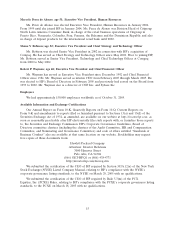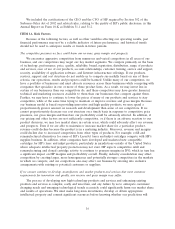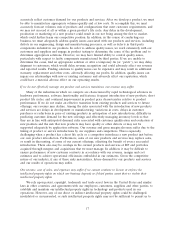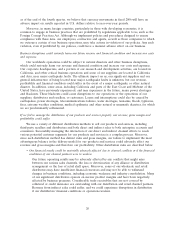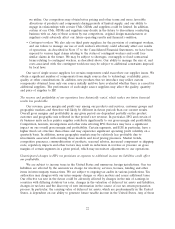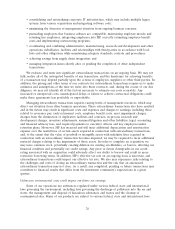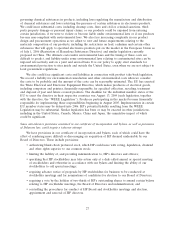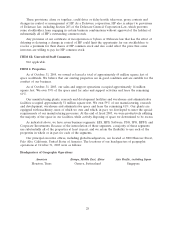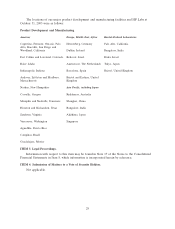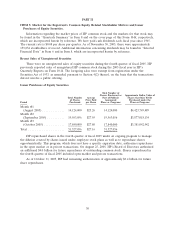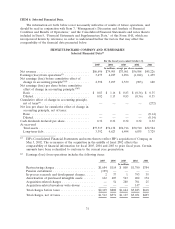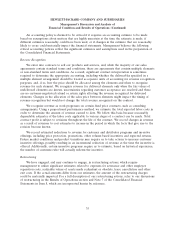HP 2005 Annual Report Download - page 29
Download and view the complete annual report
Please find page 29 of the 2005 HP annual report below. You can navigate through the pages in the report by either clicking on the pages listed below, or by using the keyword search tool below to find specific information within the annual report.System security risks and systems integration issues could disrupt our internal operations or information
technology services provided to customers, and any such disruption could harm our revenue, increase our
expenses and harm our reputation and stock price.
Experienced computer programmers and hackers may be able to penetrate our network security
and misappropriate our confidential information or that of third parties, create system disruptions or
cause shutdowns. As a result, we could incur significant expenses in addressing problems created by
security breaches of our network. Moreover, we could lose existing or potential customers for
information technology outsourcing services or other information technology solutions or incur
significant expenses in connection with our customers’ system failures. In addition, sophisticated
hardware and operating system software and applications that we produce or procure from third parties
may contain defects in design or manufacture, including ‘‘bugs’’ and other problems that could
unexpectedly interfere with the operation of the system. The costs to us to eliminate or alleviate
security problems, viruses and bugs could be significant, and the efforts to address these problems
could result in interruptions, delays or cessation of service that may impede our sales, manufacturing,
distribution or other critical functions.
Portions of our IT infrastructure also may experience interruptions, delays or cessations of service
or produce errors in connection with systems integration or migration work that takes place from time
to time. We may not be successful in implementing new systems, and transitioning data and other
aspects of the process could be expensive, time consuming, disruptive and resource-intensive. Such
disruptions could adversely impact our ability to fulfill orders and interrupt other processes. Delayed
sales, lower margins or lost customers resulting from these disruptions have adversely affected in the
past, and in the future could adversely affect, our financial results, stock price and reputation.
Any failure by us to manage acquisitions, divestitures and other significant transactions successfully could
harm our financial results, business and prospects.
As part of our business strategy, we frequently engage in discussions with third parties regarding
possible investments, acquisitions, strategic alliances, joint ventures, divestitures and outsourcing
transactions (‘‘extraordinary transactions’’) and enter into agreements relating to such extraordinary
transactions in order to further our business objectives. In order to pursue this strategy successfully, we
must identify suitable candidates for and successfully complete extraordinary transactions, some of
which may be large and complex, and manage post-closing issues such as the integration of acquired
companies or employees. Integration and other risks of extraordinary transactions can be more
pronounced for larger and more complicated transactions, or if multiple transactions are pursued
simultaneously. If we fail to identify and complete successfully extraordinary transactions that further
our strategic objectives, we may be required to expend resources to develop products and technology
internally, we may be at a competitive disadvantage or we may be adversely affected by negative market
perceptions, any of which may have a material adverse effect on our revenue, gross margin and
profitability.
Integration issues are complex, time-consuming and expensive and, without proper planning and
implementation, could significantly disrupt our business. The challenges involved in integration include:
• combining product offerings and entering into new markets in which we are not experienced;
• convincing customers and distributors that the transaction will not diminish client service
standards or business focus, preventing customers and distributors from deferring purchasing
decisions or switching to other suppliers (which could result in our incurring additional
obligations in order to address customer uncertainty), and coordinating sales, marketing and
distribution efforts;
25


